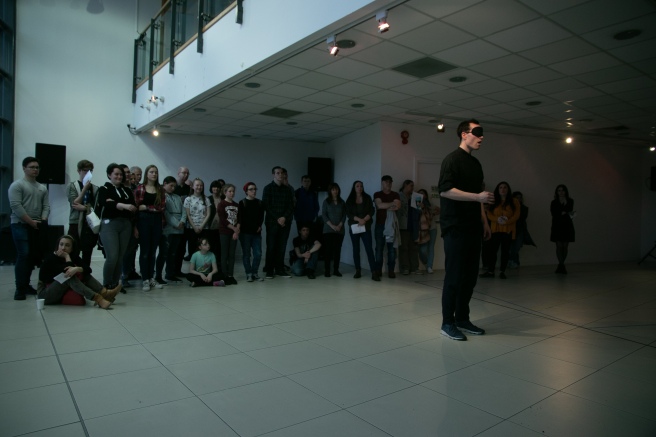by Sara Muthi
Interdisciplinary, mixed-media and expanded practice are all terms that point to the fact that boundaries within arts practice are becoming less and less relevant. Sure, you can argue and theorise about the ontologies or “essence” of a certain field (which I thoroughly enjoy to do), however this mindset often times missing the point of what’s happening within a specific work. Performance art has traditionally utilised the body (or bodies) undertaking an action (or series of actions) for a certain time in a certain place, to an audience. This form of visual arts practice has often times overlapped with other performing arts, such as theatre and dance, though now being recognised more than ever. This can be a touchy topic as both artists and performers may be uncomfortable with the idea. While these practices have traditionally been seen to occupy different fields and have majorly different priorities, considering the two within the same space can make for productive conversations on expanded practice. Performance PLATFORM is a space for such dialogues between performance art, theatre and dance to happen.
All art, in the contemporary sense at least, is not a space for answers, but a space for questions. It does not look to resolve but to further confuse apparent fundamental qualities of accepted forms and push them to unstable ground.

Robbie Blake’s practice is a good place to start in relation to overlaps between performance art and in his case, music. As an artist and composer working across many contexts of performance, he encompasses music, vocals, gestures and some degree of costume to his performances. His solo contribution to PLATFORM was nothing short of this, engaging in improvisation as is common to performance art. Similar to Blake, the Landing collective, comprised of Aliina Lindroos and Moran Been-noon, overlap the expectation of performance art with practices spanning choreography, video, installation and multimedia works. Neither Blake or Landing would either identify as ‘performance artists’ however both use the forms fluidity to explore concepts that could not otherwise emerge. Between the Landing duo rich practices of video and dance merge together to deliver a subtle yet moving performance, encompassing projection, dance and pre-recorded voices. A mixed media harmony of the digital and the body created what turned out to be a thought-provoking and multi-layered work.

A major difference that has been identified between performance art and theatre is the lack of plot or narrative within live art. Performance art always happens at the same level as life, no stage is present and audience occupies the same space as the performer. The performing body is not a representation of character but a display of the self in action. This provided an alternative context to the work of dancers Cian Coady & Mia DiChiaro and the D15 Youth Theatre. As dance and theatre would usually happen on stage, creating a distinct distance between viewer and performers, these boundaries are not humoured within the gallery. As performers perform within arm’s length to the audience, this posed new questions and challenges for each. For Coady & DiChiaro this meant a restriction of space and thus of body, unable to stretch out as would usually be encouraged in dance. For the D15 Youth Theatre this meant they had to very actively interact with the audience, posing a new challenge to their staging and script. A key element taken by both these groups is the lack of narrative or plot in their performances, aligning it within contemporary visual art lines.

This all comes full circle in the work of Lisa Freeman, working primarily as a performance artist she instead intentionally and consciously takes her performing body out of her newly developed performance Self Defeating Zone. Freeman in this case becomes the creative force as director, choreographer and costume designer. Heavily encompassing elements of theatre including script, choreography and developed characters, this work however would not suit a stage due to its audience dependent nature in which the performers confidently approached, made eye contact, directly addressed and blatantly laid on the ground before individual audience members. These actions combined with a carefully considered, intentional arrogantly-delivered script reveals how Freeman skilfully directed her performers to equally engage with a script and improvise with their surroundings, dance moves and dialogue.

As I’ve stated before, the very best art remains open to interpretation and is continuously interrogated. While nothing may have been resolved in the running of these series of interdisciplinary performances it certainly created a dialogue between practices encouraging thought about the state of performance art and it’s undeniable overlaps. Such overlaps render labels and fields of practice futile. This makes Untitled the most appropriate title.
Performance PLATFORM took place on April 3rd at 7pm in the Draíocht, Blanchardstown with performances by Robbie Blake, Cian Coady & Mia DiChiaro, Landing Collective, Lisa Freeman, D15 Youth Theatre, including an in-conversation with Sara Muthi, chaired by Sharon Murphy. Curated by Sharon Murphy. Photography by Misha Beglin.
